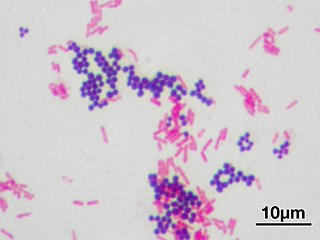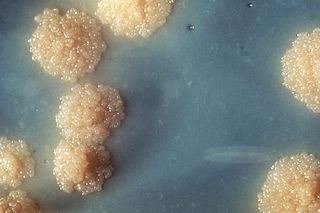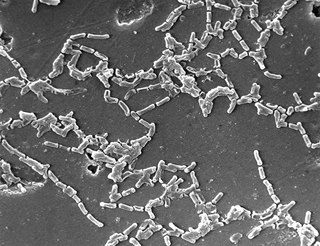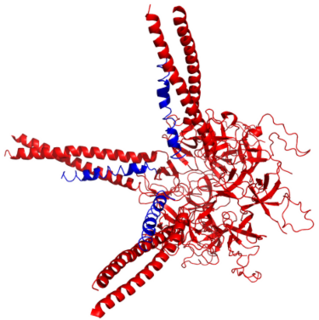Related Research Articles

Gram stain or Gram staining, also called Gram's method, is a method of staining used to classify bacterial species into two large groups: Gram-positive bacteria and Gram-negative bacteria. The name comes from the Danish bacteriologist Hans Christian Gram, who developed the technique.

Mycobacterium tuberculosis is a species of pathogenic bacteria in the family Mycobacteriaceae and the causative agent of tuberculosis. First discovered in 1882 by Robert Koch, M. tuberculosis has an unusual, waxy coating on its cell surface primarily due to the presence of mycolic acid. This coating makes the cells impervious to Gram staining, and as a result, M. tuberculosis can appear weakly Gram-positive. Acid-fast stains such as Ziehl–Neelsen, or fluorescent stains such as auramine are used instead to identify M. tuberculosis with a microscope. The physiology of M. tuberculosis is highly aerobic and requires high levels of oxygen. Primarily a pathogen of the mammalian respiratory system, it infects the lungs. The most frequently used diagnostic methods for tuberculosis are the tuberculin skin test, acid-fast stain, culture, and polymerase chain reaction.

Mycobacterium is a genus of Actinobacteria, given its own family, the Mycobacteriaceae. Over 190 species are recognized in this genus. This genus includes pathogens known to cause serious diseases in mammals, including tuberculosis and leprosy in humans. The Greek prefix myco- means "fungus," alluding to the way mycobacteria have been observed to grow in a mold-like fashion on the surface of cultures. It is acid fast and cannot be stained by the Gram stain procedure.
Mycobacterium celatum is a species of the phylum Actinobacteria, belonging to the genus Mycobacterium.

Mycobacterium chelonae is a species of the phylum Actinobacteria, belonging to the genus Mycobacterium. Mycobacterium chelonae is a rapidly growing mycobacterium, that is found all throughout the environment including sewage and tap water. It can occasionally cause opportunistic infections of humans.
Mycobacterium chitae is a species of the phylum Actinobacteria, belonging to the genus Mycobacterium.
Mycobacterium chlorophenolicum is a species of the phylum Actinobacteria, belonging to the genus Mycobacterium.
Mycobacterium diernhoferi is a species of the phylum Actinobacteria, belonging to the genus Mycobacterium.
Mycobacterium duvalii is a species of the phylum Actinobacteria, belonging to the genus Mycobacterium.
Mycobacterium elephantis, a bacterium of the family Mycobacteriaceae, was discovered and isolated from a deceased elephant near India and may be linked to respiratory dysfunction. Organisms in the genus Mycobacterium are known to be aerobic and non-motile. Organisms within Mycobacterium belong to either the rapid growing group or the slow growing group. M. elephantis is classified as a rapid grower and relates most closely to Mycobacterium confluentis and Mycobacterium phlei.
Mycobacterium fallax is a species of the phylum Actinobacteria, belonging to the genus Mycobacterium.
Mycobacterium flavescens is a species of the phylum Actinobacteria, belonging to the genus Mycobacterium.

Mycobacterium fortuitum is a nontuberculous species of the phylum Actinobacteria, belonging to the genus Mycobacterium.
Mycobacterium frederiksbergense is a species of the phylum Actinobacteria, belonging to the genus Mycobacterium.
Mycobacterium gilvum is a species of the phylum Actinobacteria, belonging to the genus Mycobacterium.
Mycobacterium gordonae is a species of Mycobacterium named for Ruth E. Gordon. It is a species of the phylum actinobacteria, belonging to the genus Mycobacterium.
Mycobacterium avium complex is a group of mycobacteria comprising Mycobacterium intracellulare and Mycobacterium avium that are commonly grouped because they infect humans together; this group, in turn, is part of the group of nontuberculous mycobacteria. These bacteria cause disease in humans called Mycobacterium avium-intracellulare infection or Mycobacterium avium complex infection. These bacteria are common and are found in fresh and salt water, in household dust and in soil. MAC bacteria usually cause infection in those who are immunocompromised or those with severe lung disease.
Mycobacterium komossense is a species of the phylum Actinobacteria, belonging to the genus Mycobacterium.

Löwenstein–Jensen medium, more commonly known as LJ medium, is a growth medium specially used for culture of Mycobacterium species, notably Mycobacterium tuberculosis.

Prokaryotic ubiquitin-like protein (Pup) is a functional analog of ubiquitin found in the prokaryote Mycobacterium tuberculosis. Like ubiquitin, Pup serves to direct proteins to the proteasome for degradation in the Pup-proteasome system (PPS). However, the enzymology of ubiquitylation and pupylation is different, owing to their distinct evolutionary origins. In contrast to the three-step reaction of ubiquitylation, pupylation requires only two steps, and thus only two enzymes are involved in pupylation. The enzymes involved in pupylation are descended from glutamine synthetase.
References
SKERMAN (V.B.D.), McGOWAN (V.) and SNEATH (P.H.A.) (editors): "Approved Lists of Bacterial Names". International Journal of Systematic Bacteriology. 1980, 30, 225–420.
TSUKAMURA (M.): "Adansonian classification of mycobacteria". Journal of General Microbiology, 1966, 45, 253–273. PMID 4961417